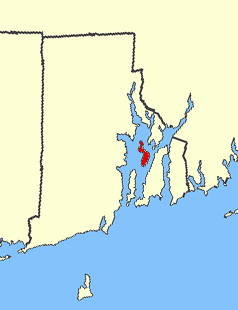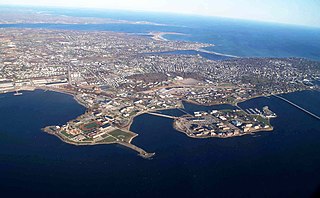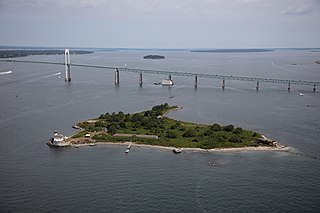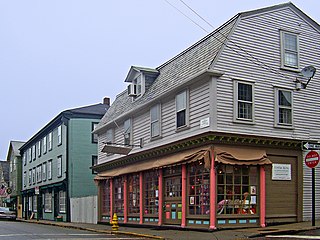
Newport is an American seaside city on Aquidneck Island in Newport County, Rhode Island. It is located in Narragansett Bay, approximately 33 miles (53 km) southeast of Providence, 20 miles (32 km) south of Fall River, Massachusetts, 74 miles (119 km) south of Boston, and 180 miles (290 km) northeast of New York City. It is known as a New England summer resort and is famous for its historic mansions and its rich sailing history.

Jamestown is a town in Newport County, Rhode Island in the United States. The population was 5,559 at the 2020 census. Jamestown is situated almost entirely on Conanicut Island, the second largest island in Narragansett Bay. It also includes the uninhabited Dutch Island and Gould Island.

Bristol is a town in Bristol County, Rhode Island, US as well as the historic county seat. It is a deep water seaport named after Bristol, England.

Prudence Island is the third-largest island in Narragansett Bay in the state of Rhode Island and part of the town of Portsmouth, Rhode Island, United States. It is located near the geographic center of the bay. It is defined by the United States Census Bureau as Block Group 3, Census Tract 401.03 of Newport County, Rhode Island. As of the 2010 census, the population was 278 people living on a land area of 14.43 km2.

The Naval War College is the staff college and "Home of Thought" for the United States Navy at Naval Station Newport in Newport, Rhode Island. The NWC educates and develops leaders, supports defining the future Navy and associated roles and missions, supports combat readiness, and strengthens global maritime partnerships.

The Naval Station Newport is a United States Navy base located in the city of Newport and the town of Middletown, Rhode Island. Naval Station Newport is home to the Naval War College and the Naval Justice School. It once was the homeport for Cruiser Destroyer Force Atlantic (COMCRUDESLANT), which relocated to Naval Station Norfolk in the early 1970s. In 1989 the base was added to the National Priorities List, after contamination had been discovered years earlier. Newport now maintains inactive ships at its pier facilities, along with the United States Coast Guard. In BRAC 2005, NAVSTA Newport gained over five hundred billets, in addition to receiving, again, the Officer Candidate School (OCS), the Naval Supply Corps School, and several other activities, to include a few Army Reserve units.

Stephen Bleecker Luce was a U.S. Navy admiral. He was the founder and first president of the Naval War College, between 1884 and 1886.

Fort Adams is a former United States Army post in Newport, Rhode Island that was established on July 4, 1799 as a First System coastal fortification, named for President John Adams who was in office at the time. Its first commander was Captain John Henry who was later instrumental in starting the War of 1812. The current Fort Adams was built 1824–57 under the Third System of coastal forts; it is part of Fort Adams State Park today.

Goat Island is a small island in Narragansett Bay and is part of the city of Newport, Rhode Island, U.S. The island is connected to the Easton's Point neighborhood via a causeway bridge. It is home to the Newport Harbor Light (1842), residences, a restaurant, event space, and hotel. It was also home to several military forts and to the U.S. Naval Torpedo Station, and was the site of the attacks on HMS St John and HMS Liberty.

Beavertail State Park is a public recreation area encompassing 153 acres (62 ha) at the southern end of Conanicut Island in Narragansett Bay, Rhode Island. The state park's main attraction is the active Beavertail Lighthouse, the current tower of which dates from 1856. During World War II, the park area was part of Fort Burnside, one of several coastal fortifications designed to protect Narragansett Bay. The park's scenic shoreline offers hiking, picnicking, and saltwater fishing.

Beavertail Lighthouse was built in 1856 and is the premier lighthouse in Rhode Island, marking the entrance to Narragansett Bay. The 64-foot (20 m) lighthouse lies on the southernmost point of Conanicut Island in the town of Jamestown, Rhode Island in Beavertail State Park, on a site where beacons have stood since the early 18th century. The light provides navigation for boats and ships entering Narragansett Bay in the East Passage between Conanicut Island and Newport, Rhode Island on Aquidneck Island. Other lighthouses are visible from Beavertail Lighthouse, such as Castle Hill Lighthouse, Point Judith Light, and Rose Island Light.

Smith's Castle, built in 1678, is a house museum at 55 Richard Smith Drive, near Wickford, a village in North Kingstown, Rhode Island, United States. Smith's Castle is one of the oldest houses in the state. It was designated a National Historic Landmark in 1993 as Cocumscussoc Archeological Site, due to the artifacts and information digs in the vicinity have yielded. It is located just off U.S. 1.
Coasters Harbor Island is a 92-acre (370,000 m2) island in Narragansett Bay, Newport, Rhode Island. The island is home to the Naval War College (NWC), an education and research institution of the United States Navy that specializes in developing ideas for naval warfare and passing them along to officers of the Navy.

Rose Island is an 18.5-acre (7.5 ha) island in Narragansett Bay off Newport, Rhode Island, United States. It is allegedly named "Rose Island" because at low tide the island appears to be shaped like a rose. The Island is only accessible by boat. The island and its lighthouse are run by the private, non-profit Rose Island Lighthouse Foundation.

The Newport Historic District is a historic district that covers 250 acres in the center of Newport in the U.S. state of Rhode Island. It was designated a National Historic Landmark (NHL) in 1968 due to its extensive and well-preserved assortment of intact colonial buildings dating from the early and mid-18th century. Six of those buildings are themselves NHLs in their own right, including the city's oldest house and the former meeting place of the colonial and state legislatures. Newer and modern buildings coexist with the historic structures.

Luce Hall was the first purpose-built building for the U.S. Naval War College, founded at Newport, Rhode Island, in 1884. It is located at Building 1, Luce Avenue, Naval Station Newport. The building is named after Rear Admiral Stephen Luce.

The president of the Naval War College is a flag officer in the United States Navy. The President's House in Newport, Rhode Island is their official residence.

The Hattendorf Prize for Distinguished Original Research in Maritime History is awarded by the United States Naval War College for distinguished academic achievement in publishing original research that contributes to a deeper historical understanding of the broad context and interrelationships involved in the roles, contributions, limitations, and uses of the sea services in history. The prize is awarded approximately every two years and consists of a $10,000 cash prize, a specially designed bronze medal, and a citation. The Prize Laureate is expected to deliver a lecture at the United States Naval War College on the occasion of the award.

William McCarty Little was a United States Navy officer of the late 19th century. He is most noted for his contributions to the development of naval wargaming at the United States Naval War College in Newport, Rhode Island.



















